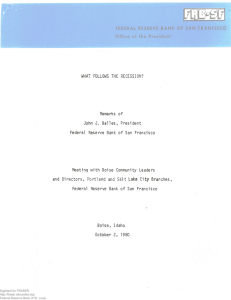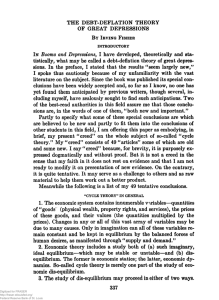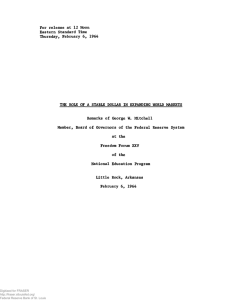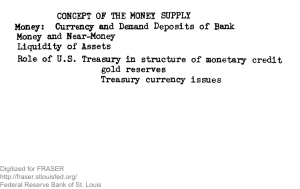Letter to Mr. McKee
advertisement
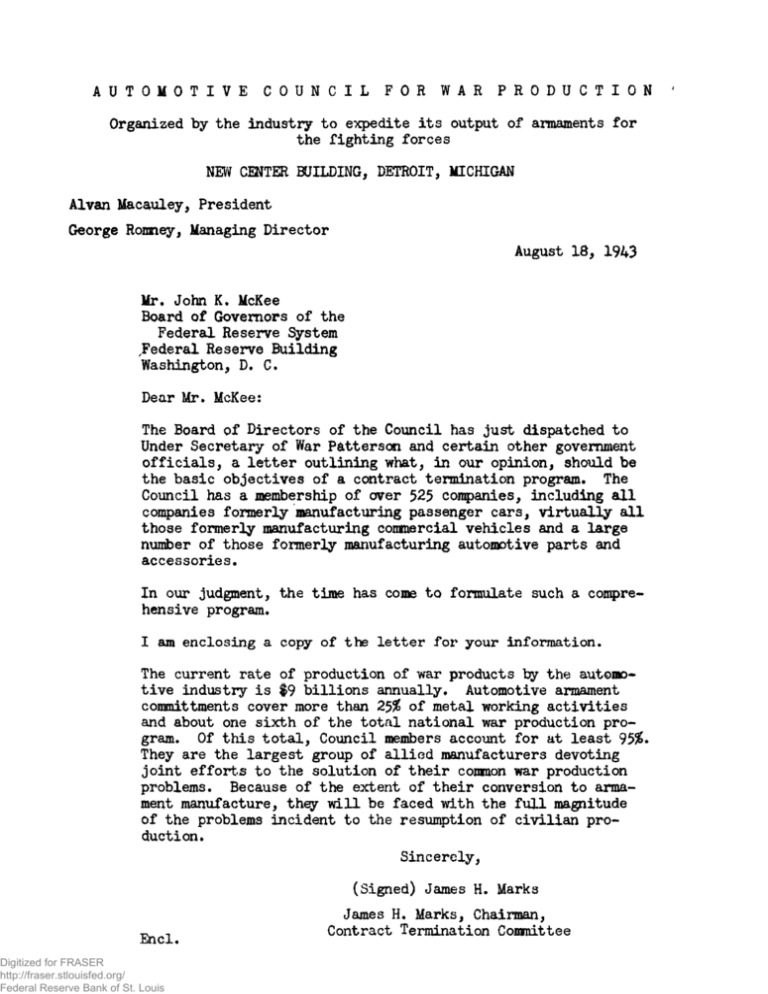
A U T O M O T I V E COUNCIL FOR WAR P R O D U C T I O N Organized by the industry to expedite its output of armaments for the fighting forces NEW CENTER BUILDING, DETROIT, MICHIGAN Alvan Macauley, President George Romney, Managing Director August 18, 1943 Mr. John K. McKee Board of Governors of the Federal Reserve System .Federal Reserve Building Washington, D. C. Dear Mr. McKee: The Board of Directors of the Council has just dispatched to Under Secretary of War Patterson and certain other government officials, a letter outlining what, in our opinion, should be the basic objectives of a contract termination program. The Council has a membership of over 525 companies, including all companies formerly manufacturing passenger cars, virtually all those formerly manufacturing commercial vehicles and a large number of those formerly manufacturing automotive parts and accessories. In our judgment, the time has come to formulate such a comprehensive program. I am enclosing a copy of the letter for your information. The current rate of production of war products by the automotive industry is $9 billions annually. Automotive armament committments cover more than 25% of metal working activities and about one sixth of the total national war production program. Of this total, Council members account for at least 95$. They are the largest group of allied manufacturers devoting joint efforts to the solution of their common war production problems. Because of the extent of their conversion to armament manufacture, they will be faced with the full magnitude of the problems incident to the resumption of civilian production. Sincerely, „ T End. Digitized for FRASER http://fraser.stlouisfed.org/ Federal Reserve Bank of St. Louis (Signed) James H. Marks James H. Marks, Chairman, Contract Termination Committee A U T O M O T I V E COUNCIL FOR WAR P R O D U C T I O N Organized by the industry to expedite its output of armaments for the fighting forces NEW CENTER BUILDING, DETROIT, MICHIGAN Alvan Macauley, President George Romney, Managing Director NOT FOR August 7, 1943 Irrespective of when a successful conclusion of the war may be expected, the automotive industry as represented in the Automotive Council for War Production and through its Board of Directors, believes the time has come to prepare a comprehensive program for the full scale, prompt and orderly demobilization of war industry once hostilities terminate Accordingly, we urge that the responsible agencies of Government join now in development of such a program, so that when the time finally arrives, the needed prompt and orderly transition from war to peace economy will become possible. Obviously, if the end of the war should find us with no plan or one difficult to administer, the consequences to the national economy would be critical. Re-employment of millions of workers would be delayed months longer than necessary. But, since the first groups of substantial cancellations of contracts have recently been made as a result of changing military requirements, valuable experience is already at hand to guide in determining effective procedure. Involved in war contract termination will be the capacity of the country's industry to handle its necessary reconversion from war work, and to re-employ tens of millions of men and women, including those returning from the services. Most industry, financially over-extended to handle the war load, will be dependent on Government settlements to make its start. Past history of contract settlements emphasizes that existing procedures, even applied on a limited scale, involve delays that under present conditions would be fatal to a large proportion of business. The country, we believe, should prepare for the possibility that termination will arrive at a time when war production still is at peak rate. As a contribution toward the necessary planning, we wish to submit that certain principles appear to us to form the core of any constructive demobilization program. 1. Organization and Authority. The huge task of releasing industry from its war commitments will require the creation of adequate Governmental organization, fully empowered to Digitized for FRASER http://fraser.stlouisfed.org/ Federal Reserve Bank of St. Louis -2effect prompt and final settlements. A clear understanding of the ground rules by both Government and Industry will expedite settlements. 2. Unified Policy* Equitable handling of the demobilization program cannot be obtained unless all agencies concerned in procurement, accounting and fiscal policy, including the General Accounting Office, operate under definite, clearly established and dependable procedure. 3. Promptne3s of Payment. The manufacturers of war products cannot stand much delay in payment after termination. Needed, are methods by which at least a major portion of the sums involved can be disbursed immediately. 4. Equitable Settlements and Protection of the Public interest. A sound liquidation program will require settlements that are fair both to the tax-paying public and to contractors. The public interest cannot be well served if the making of equitable settlements is so delayed as to interfere with the speedy reconversion to civilian production. 5. Disposal of Equipment. The Government Departments own billions of dollars worth of machine tools and equipment now in private plants. In general, these tools will be in the way of civilian production. Industry moved its own tools out of the plants as an initial step in conversion to war. The Government should make plans now to authorize prompt removal of its equipment. If this is not done, millions will be out of work longer than necessary. 6. Disposal of Inventories. The typical plant will have its floors full of war material when the war ends. So long as this war material is held in the plant pending Governments final valuation of work performed, or decision as to its disposal, the plant and its capital cannot be turned back to peace production. Provision for the immediate removal of such materials should be part of the program to clear the way for re-employment. 7. Utilization of Government-Owned Plant and Tooj.s. Government demobilization plans should include a definite program as to plant and tools to be retained and provision for disposal of such Government-owned buildings, sites and tools as arc not to be retained. 8. Protection of Subcontractors. No program can be sound that* does not provide means for protecting secondary contractors. Utilization of subcontractors by the hundreds and thousands under single prime contracts, and in many cases interlocking under hun-r dreds of separate prime contracts, has been a conspicuous feature Digitized for FRASER http://fraser.stlouisfed.org/ Federal Reserve Bank of St. Louis -3of the Government's war production program. These firms are as much in need of prompt and equitable settlements as prime contractors. Many are small companies. Many would be bankrupted by protracted delay in settlement. Still others would be injured conpetitively by being unable to finance reconversion pending settlements. The equities involved emphasize the need for a vital, over-all national demobilization plan. We recognize that the full scope of the reconversion job is much larger than the few enumerated principles. Collateral policies on such matters as the availability of industrial reserves for reconversion, the relation of renegotiation methods to cancellation procedure, and similar matters are involved. The automotive industry is carrying, and expects to carry as long as necessary, a tremendous portion of the war production load. It will require virtually 100 percent reconversion. An overall program for our industry is particularly important because the production of automobiles by every company is based on a network of sub-contractors. Its integrated character makes it necessary for the whole chain of plants supplying various parts to resume production before motor vehicles can be manufactured. Inability to get wheels, valves, springs or any other part would delay production. As one of the large producers of needed civilian goods, the Industry will be expected to do its part in creating post-war employment on a large scale, and returning the country into a cycle of civilian economy. The Industry's ability to perform will depend in large measure on the success of Government in working out successful termination procedures. Accordingly, this Council has established a special committee on termination of contracts, to analyze the situation. The connittee will be working continuously at this study. The committee is composed of — Chairman, J, H. Marks, Vice President Packard Motor Car Company K. J. Ammerman Ass't to the President Borg-Warner Corporation I. B. Babcock President Yellow Truck & Coach Mfg. Co. Albert Bradley Executive Vice President General Motors Corporation E. R. Breech President Bendix Aviation Corporation W. P. Brown President Briggs Manufacturing Co. D. J. Buell Secretary-Treasurer Buell Die & Machine Co. Digitized for FRASER http://fraser.stlouisfed.org/ Federal Reserve Bank of St. Louis -4C. C. Carlton Vice President-Secretary Motor Wheel Corporation E. A. Clark Vice President Budd Wheel Company B. E. Hutchinson, Chairman Finance Committee Chrysler Corporation H. L. Moekle Secretary and Ass't Treasurer Ford Motor Company M, I. Peale Vice President Republic Aviation Corp. A. M. Wibel Vice President Nash-Kelvinator Corporation The Automotive Council desires to be helpful in this situation, and its cooperation is tendered to all those officials and agencies of Government responsible for evolving and administering this concluding segment of the war effort. Digitized for FRASER http://fraser.stlouisfed.org/ Federal Reserve Bank of St. Louis Sincerely yours, Alvan Macauley President




